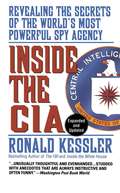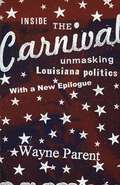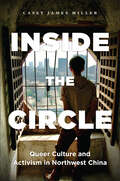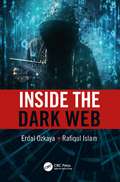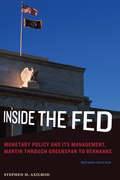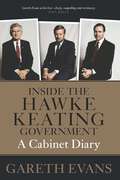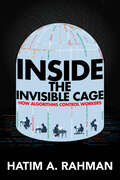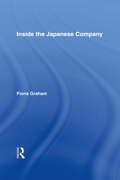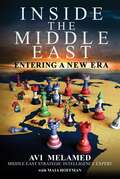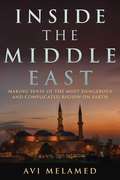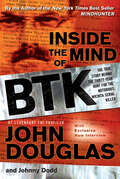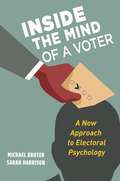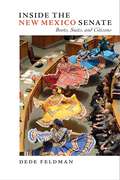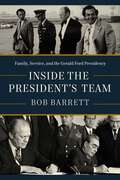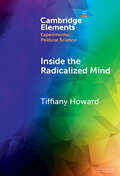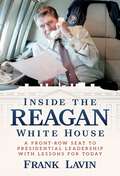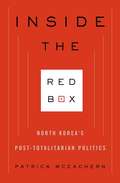- Table View
- List View
Inside the CIA: Revealing the Streets of the World's Most Powerful Spy Agency
by Ronald KesslerExamination of the CIA from the perspective of its prominent directors, veteran officers, and significant critics
Inside the Carnival: Unmasking Louisiana Politics
by Wayne ParentWith both an entertainer’s eye and a social scientist’s rigor, Wayne Parent subjects Louisiana’s politics to rational and empirical analysis, seeking and finding coherent reasons for the state’s well-known unique history. He resists resorting to vague hand-waving about “exoticism,” while at the same time he brings to life the juicy stories that illustrate his points. Pa rent’s main theme is that Louisiana’s ethnic mix, natural resources, and geography define a culture that in turn produces its unique political theater. He gives special attention to immigration patterns and Louisiana’s abundant supply of oil and gas, as well as to the fascinating variations in political temperaments in different parts of the state. Most important, he delivers thorough and concise explanations of Louisiana’s unusual legal system, odd election rules, overwrought constitutional history, convoluted voting patterns, and unmatched record of political corruption. In a new epilogue, Parent discusses how the hurricanes of 2005 will affect state politics and politicians as Louisiana struggles to regain its footing in the New South.
Inside the Circle: Queer Culture and Activism in Northwest China
by Casey James MillerDrawing on over a decade of ethnographic fieldwork in northwest China, Casey James Miller offers a novel, compelling, and intimately personal perspective on Chinese queer culture and activism. In Inside the Circle: Queer Culture and Activism in Northwest China, Miller tells the stories of two courageous and dedicated groups of queer activists in the city of Xi’an: a grassroots gay men’s HIV/AIDS organization called Tong’ai and a lesbian women’s group named UNITE. Taking inspiration from “the circle,” a term used to imagine local, national, and global queer communities, Miller shows how everyday people in northwest China are taking part in queer culture and activism while also striving to lead traditionally moral lives in a rapidly changing society. The queer stories in this book broaden our understandings of gender and sexuality in contemporary China and show how taking global queer diversity seriously requires us to de-center Western cultural values, historical experiences, and theoretical perspectives.
Inside the Dark Web
by Rafiqul Islam Erdal OzkayaInside the Dark Web provides a broad overview of emerging digital threats and computer crimes, with an emphasis on cyberstalking, hacktivism, fraud and identity theft, and attacks on critical infrastructure. The book also analyzes the online underground economy and digital currencies and cybercrime on the dark web. The book further explores how dark web crimes are conducted on the surface web in new mediums, such as the Internet of Things (IoT) and peer-to-peer file sharing systems as well as dark web forensics and mitigating techniques. This book starts with the fundamentals of the dark web along with explaining its threat landscape. The book then introduces the Tor browser, which is used to access the dark web ecosystem. The book continues to take a deep dive into cybersecurity criminal activities in the dark net and analyzes the malpractices used to secure your system. Furthermore, the book digs deeper into the forensics of dark web, web content analysis, threat intelligence, IoT, crypto market, and cryptocurrencies. This book is a comprehensive guide for those who want to understand the dark web quickly. After reading Inside the Dark Web, you’ll understand The core concepts of the dark web. The different theoretical and cross-disciplinary approaches of the dark web and its evolution in the context of emerging crime threats. The forms of cybercriminal activity through the dark web and the technological and "social engineering" methods used to undertake such crimes. The behavior and role of offenders and victims in the dark web and analyze and assess the impact of cybercrime and the effectiveness of their mitigating techniques on the various domains. How to mitigate cyberattacks happening through the dark web. The dark web ecosystem with cutting edge areas like IoT, forensics, and threat intelligence and so on. The dark web-related research and applications and up-to-date on the latest technologies and research findings in this area. For all present and aspiring cybersecurity professionals who want to upgrade their skills by understanding the concepts of the dark web, Inside the Dark Web is their one-stop guide to understanding the dark web and building a cybersecurity plan.
Inside the Dream Palace: The Life and Times of New York's Legendary Chelsea Hotel
by Sherill TippinsWinner of the National Award for Arts Writing: &“If there were a course in Chelsea Hotel-iana, this would be the textbook&” (The New York Times). It&’s where Dylan Thomas lived his last days, Bob Dylan wrote Blonde on Blonde, and Arthur C. Clarke wrote 2001: A Space Odyssey. It is memorialized by many of its famous inhabitants: Andy Warhol filmed Chelsea Girls there, and Leonard Cohen wrote Chelsea Hotel #2 about his tryst with Janis Joplin. Since its founding by a utopian-minded French architect in 1884, New York&’s Chelsea Hotel has been a hotbed of artistic invention and inspiration. Cultural luminaries from Sid Vicious to Thomas Wolfe, Edith Piaf to Patti Smith, Jean-Paul Sartre to Dee Dee Ramone—all made the Chelsea the largest and longest-lived artist community in the world. Inside the Dream Palace tells the hotel&’s story, from its earliest days as a cooperative community, through its pop art, rock-and-roll, and punk periods, to its later transformations under new ownership. With this lively and fascinating history, &“Tippins tells riveting stories about the Chelsea&’s artists, but she also captures a much grander, and more pressing, narrative: that of the ongoing battle between art and capitalism in the city&” (The New Yorker). &“An inspired investigation into the utopian spirit of the Chelsea Hotel.&” —Elle &“An impossible order for any writer: Get the Chelsea&’s romance down on paper and try to keep up with Patti Smith and Joni Mitchell and Arthur Miller. But Sherill Tippins&’s history does a vivid job of taking you up into those seedy, splendid hallways, now gone forever.&” —New York magazine &“Tippins succeeds where other historians studying New York landmarks have failed: She understands that even the most splendid buildings are mere settings for the personalities that inhabit them, and wisely bypasses rote chronology for the vigor of cultural excavation.&” —Time Out New York &“Not only essential to the understanding of this crucial New York City—and therefore American—cultural landmark, but as majestic and populous as the edifice itself, and completely entertaining.&” —Daniel Menaker, author of My Mistake
Inside the Fed, revised edition: Monetary Policy and Its Management, Martin through Greenspan to Bernanke
by Stephen H. AxilrodAn insider's account of the workings of the Federal Reserve, thoroughly updated to encompass the Fed's action (and inaction) during the recent financial meltdown.Stephen Axilrod is the ultimate Federal Reserve insider. He worked at the Fed's Board of Governors for more than thirty years and after that in private markets and as a consultant on monetary policy. With Inside the Fed, he offers his unique perspective on the inner workings of the Federal Reserve System during the last fifty years. This new, post-financial meltdown edition offers his assessment of the Fed's action (and inaction) during the crisis and expanded coverage of the Fed in the Bernanke era.Great leadership in monetary policy, Axilrod says, is determined not by pure economic sophistication but by the ability to push through political and social barriers to achieve a paradigm shift in policy—and by the courage and bureaucratic moxie to pull it off.
Inside the Fed: Monetary Policy and Its Management, Martin Through Greenspan to Bernanke
by Stephen H. AxilrodStephen Axilrod is the ultimate Federal Reserve insider. He worked at the Fed's Board of Governors for over thirty years and after that in private markets and as a consultant on monetary policy. With Inside the Fed,he offers his unique perspective on the inner workings of the Federal Reserve System during the last fifty years--writing about personalities as much as policy--based on his knowledge and observations of every Fed chairman since 1951. Axilrod's discussion focuses on how the personalities of the various chairmen affected their capacity for leadership. He describes, for example, Arthur Burns's response to political pressure from the Nixon White House and Paul Volcker's radical shift to an anti-inflationary policy at the end of the 1970s--a transition in which Axilrod himself played a crucial role. As for the Greenspan years, Axilrod points to the unintended effects of the Fed's newfound "garrulousness" (the plethora of announcements and hints about policy intentions)--one of which was the Fed's loss of credibility in the aftermath of the chairman's 1996 comment about "irrational exuberance." And Axilrod incisively outlines the problems--including the subprime mess--inherited from Greenspan by the current chairman, Ben Bernanke. Great leadership in monetary policy, Axilrod says, is determined not by pure economic sophistication but by the ability to push through political and social barriers to achieve a paradigm shift in policy--and by the courage and bureaucratic moxie to pull it off.
Inside the Five-Sided Box: Lessons from a Lifetime of Leadership in the Pentagon
by Ash CarterThe twenty-fifth Secretary of Defense takes readers behind the scenes to reveal the inner workings of the Pentagon, its vital mission, and what it takes to lead it. The Pentagon is the headquarters of the single largest institution in America: the Department of Defense. The D.O.D. employs millions of Americans. It owns and operates more real estate, and spends more money, than any other entity. It manages the world’s largest and most complex information network and performs more R&D than Apple, Google, and Microsoft combined. Most important, the policies it carries out, in war and peace, impact the security and freedom of billions of people around the globe. Yet to most Americans, the dealings of the D.O.D. are a mystery, and the Pentagon nothing more than an opaque five-sided box that they regard with a mixture of awe and suspicion. In this new book, former Secretary of Defense Ash Carter demystifies the Pentagon and sheds light on all that happens inside one of the nation’s most iconic, and most closely guarded, buildings. Drawn from Carter’s thirty-six years of leadership experience in the D.O.D., this is the essential book for understanding the challenge of defending America in a dangerous world—and imparting a trove of incisive lessons that can guide leaders in any complex organization. In these times of great disruption and danger, the need for Ash Carter’s authoritative and pragmatic account is more urgent than ever.
Inside the Green Lobby: The Fight to Save the Adirondack Park (Excelsior Editions)
by Bernard C. MelewskiInside the Green Lobby recounts the behind-the-scenes efforts, both at the State Capitol in Albany and the halls of Congress, of a lobbyist for a major environmental advocacy group. Bernard C. Melewski worked to save the six-million acre Adirondack Park from twin threats to its future: the devastating damage from acid rain and the sudden breakup of massive private land holdings that had been intact for almost one hundred years. Starting with the political uproar ignited by the recommendations of New York Governor Mario Cuomo’s 1990 Adirondack Park Commission, and the rejection by the public of a new environmental bond act, Inside the Green Lobby documents the events that led to the sudden acquisition by New York State of tens of thousands of acres within the park that the public now enjoys. From strategy sessions with lobbyists to private meetings with legislators, governors, members of Congress, and even the President of the United States, Melewski recounts engaging and entertaining stories that introduce how environmental advocates successfully pursue legislative and policy change.
Inside the Hawke–Keating Government: A Cabinet Diary
by Gareth EvansAs good as it gets in Australian politics. That's how the Hawke-Keating Government is now widely regarded. But how did this highly able, ambitious, strong-willed group work through its crises and rivalries, and achieve what it did? Gareth Evans' diary, written in the mid-1980s and published now for the first time, is the consummate insider's account. It not only adds much new material to the historical record, but is perceptive, sharp and unvarnished in its judgments, lucidly written, and often highly entertaining.
Inside the Invisible Cage: How Algorithms Control Workers
by Hatim RahmanIn a world increasingly run by algorithms and artificial intelligence, Hatim Rahman traces how organizations are using algorithms to control workers in an "invisible cage." Inside the Invisible Cage uses unique longitudinal data to investigate how digital labor platforms use algorithms to dictate the actions of high-skilled workers by determining accepted behaviors, work opportunities, and even success. As Hatim Rahman explains, employers can use algorithms to shift rules and guidelines without notice, explanation, or recourse for workers. The invisible cage signals a profound shift in the way markets and organizations categorize and ultimately control people. Unlike previous forms of labor control, the invisible cage is ubiquitous, yet it is also opaque and shifting, which makes breaking free from it difficult for workers. This book traces how the invisible cage was developed over time and the implications it has for the spread of new technology, such as generative artificial intelligence. Inside the Invisible Cage also provides organizations, workers, and policymakers with insights on how to ensure the future of work has truly equitable, mutually beneficial outcomes.
Inside the Japanese Company
by Fiona GrahamGraham explores the attitudes of Japanese employees towards their work, their company and on related issues. Based on extensive original research inside a Japanese insurance company (C-Life), which subsequently went bankrupt, the book shows that attitudes towards lifetime employment, company loyalty and the other characteristics of Japanese working life, which are often portrayed in stereotype form in the West, are in fact more complicated than is at first apparent.
Inside the Middle East: Entering a New Era
by Avi MelamedWhy Is the Middle East Entering a &“New Era?&” Is It a New Dawn? Is It a Setting Sun? In the third decade of the twenty-first century, the Middle East is entering a new era. A multifaceted and intricate equilibrium will write the next chapter of this region. The new era we are entering is fraught with challenges and full of opportunities. The new era is both defined by, and a result of, a combination of ancient and modern, domestic, regional, and international processes. Iran and Turkey each strive to position themselves as the regional superpower. In parallel, the people of the region struggle to overcome increasing domestic challenges. These developments, combined with an escalating struggle over path, identity, and direction, could result in a new model of statehood in the Arab world. While some countries take the turbulent path toward a possible new statehood model, others are fighting for their sovereignty and survival. All of this is occurring while Western hegemony in the Middle East is coming to an end and the Eastern giants are on the rise. Acclaimed Middle East expert, an Israeli fluent in Arabic, English, and Hebrew, Avi Melamed has a proven exceptional record of foreseeing the evolution of events in the Middle East and their impact on a local and regional level. In this book, Melamed takes you on a fascinating eye-opening journey through the geopolitical landscape of the Middle East in the third decade of the twenty first century. He challenges common Western concepts, narratives, and theories. And he provides predictions about some of the most central regional issues of the day. Using primarily sources from the region, Avi Melamed provides a professional, rare insider&’s view and clearly and insightfully contextualizes current regional events. Inside The Middle East: Entering a New Era provides the knowledge and tools to connect the dots. This distinct understanding allows the reader to build a multidimensional picture of the geopolitical reality of the Middle East today and provides an unparalleled foundation for navigating the events of tomorrow.
Inside the Middle East: Making Sense of the Most Dangerous and Complicated Region on Earth
by Avi Melamed Lucy AharishAcclaimed Israeli intelligence analyst Avi Melamed has spent more than thirty years interpreting Middle East affairs. His long-awaited Inside the Middle East challenges widely-accepted perceptions and provides a gripping and uniquely enlightening guide to make sense of the events unfolding in the region-to answer how the Arab world got to this point, what is currently happening, what the ramifications will be, how they will affect Israel, and what actions must immediately be undertaken, including how Western leaders need to respond.Melamed considers all the major power players in the Middle East, explains the underlying issues, and creates a three-dimensional picture, an illustration that connects the dots and provides a fascinating roadmap. He elucidates developments such as the Arab Spring, the downfall of the Muslim Brotherhood, the rise of ISIS, the epic Sunni-Shiite animosity, the essence of the war in Syria, the role of the Caliphate and Jihad, and the looming nuclear arms race. He also provides a rare opportunity to journey into the psyche of Arab society. Look through the lens of its leaders and its most ruthless terrorists. See what makes them tick and what they want. Discover how they can be overtaken.This unparalleled volume is a milestone in our understanding of the Middle East. It is the untold story of the struggles that will shape the region, and the world, for decades to come, and a groundbreaking guide that will shake you to the core, force you to reevalute your outlook, and give you tips to navigate the future.From author Avi Melamed:The conflicts in the Middle East grow more confusing and dangerous every day.In my encounters with thousands of people from across the world - from global leaders to high school students - I know there is deep and intense thirst for knowledge because today understanding the Middle East is not optional - it’s mandatory.My new book, Inside the Middle East: Making Sense of the Most Dangerous and Complicated Region on Earth is based on my decades of advisory, counterterrorism, education, and intelligence - positions - as well as my intimate connections throughout the Arab world.The book also provides the building blocks and database to understand the contemporary Middle East, offers a unique insight into the Arab world, and is "a GPS to help you navigate the dramatically changing Middle East.”In the book, I also offer an out of the box idea that could lead to a positive breakthrough in the Israeli- Palestinian conflict.
Inside the Mind of BTK: The True Story Behind the Thirty-Year Hunt for the Notorious Wichita Serial Killer
by John Douglas Johnny DoddThe FBI profiler & co-author of the #1 New York Times–bestseller Mindhunter recounts his role in catching one of America&’s most notorious serial killers.Inside the Mind of BTK tells the incredible true story of how FBI profiler John Douglas tracked and participated in the hunt for one of the most notorious serial killers in US history. For thirty-one years a man who called himself BTK (Bind, Torture, Kill) terrorized the city of Wichita, Kansas, sexually assaulting and strangling a series of victims, taunting the police with cryptic communications, and bragging about his vicious crimes to local newspapers and television stations. After disappearing for nine years, he suddenly reappeared, complaining that no one was paying enough attention to him and claiming that he had committed other crimes for which he had not been given credit. When he was finally captured, BTK was revealed to be Dennis Rader, a sixty-one-year-old churchgoing, married man with two children. As a leading serial killer profiler for the FBI, John Douglas was first called to consult about the case in 1980 and remained involved with the story and all of its principal players up to the arrest and prosecution. After Rader was arrested, Douglas was granted both an exclusive interview with the killer after his sentencing, as well as access to friends, family, and police. In this page-turning book, Douglas reveals both new information and insight into why Rader did what he did, why he stopped for a mysterious nine-year period, and his current psychological state in custody. Praise for Inside the Mind of BTK &“Legendary profiler and bestselling author Douglas (Mindhunter), who pioneered the FBI&’s systematic study of serial killers, offers his insights into one of this country&’s most chilling killers—Dennis Rader, a seemingly innocuous family man and municipal employee, whose brutal murders terrorized Wichita, Kans., for three decades. . . . While the stomach-turning story of BTK's crimes has been told by others, Douglas's unique professional experience and his exclusive personal access to Rader offers a different perspective, even as the answer to the question of how such a monster comes to be remains elusive.&” —Publishers Weekly&“Riveting! Douglas and Dodd have focused a laser sight on one of the most fascinating and disturbing serial killers of our time. Their in-depth analysis of BTK&’s early childhood, his seemingly &“normal&” everyday life, and his shockingly well-hidden &“other&” life deftly explores the nature of evil and how we can better protect ourselves from such cunning predators.&” ―Lisa Gardner, New York Times–bestselling suspense author of Hide
Inside the Mind of a Voter: A New Approach to Electoral Psychology
by Sarah Harrison Michael BruterAn in-depth look into the psychology of voters around the world, how voters shape elections, and how elections transform citizens and affect their livesCould understanding whether elections make people happy and bring them closure matter more than who they vote for? What if people did not vote for what they want but for what they believe is right based on roles they implicitly assume? Do elections make people cry? This book invites readers on a unique journey inside the mind of a voter using unprecedented data from the United States, the United Kingdom, Germany, France, South Africa, and Georgia throughout a period when the world evolved from the centrist dominance of Obama and Mandela to the shock victories of Brexit and Trump. Michael Bruter and Sarah Harrison explore three interrelated aspects of the heart and mind of voters: the psychological bases of their behavior, how they experience elections and the emotions this entails, and how and when elections bring democratic resolution. The authors examine unique concepts including electoral identity, atmosphere, ergonomics, and hostility.From filming the shadow of voters in the polling booth, to panel study surveys, election diaries, and interviews, Bruter and Harrison unveil insights into the conscious and subconscious sides of citizens’ psychology throughout a unique decade for electoral democracy. They highlight how citizens’ personality, memory, and identity affect their vote and experience of elections, when elections generate hope or hopelessness, and how subtle differences in electoral arrangements interact with voters’ psychology to trigger different emotions.Inside the Mind of a Voter radically shifts electoral science, moving away from implicitly institution-centric visions of behavior to understand elections from the point of view of voters.
Inside the NRA: A Tell-All Account of Corruption, Greed, and Paranoia within the Most Powerful Political Group in America
by Joshua L. PowellA shocking exposé of rampant, decades-long incompetence at the National Rifle Association, as told by a former member of its senior leadership.Joshua L. Powell is the NRA--a lifelong gun advocate, in 2016, he began his new role as a senior strategist and chief of staff to NRA CEO Wayne LaPierre. What Powell uncovered was horrifying: "the waste and dysfunction at the NRA was staggering."INSIDE THE NRA reveals for the first time the rise and fall of the most powerful political organization in America--how the NRA became feared as the Death Star of Washington lobbies and so militant and extreme as "to create and fuel the toxicity of the gun debate until it became outright explosive."INSIDE THE NRA explains this intentional toxic messaging was wholly the product of LaPierre's leadership and the extremist branding by his longtime PR puppet master Angus McQueen. In damning detail, Powell exposes the NRA's plan to "pour gasoline" on the fire in the fight against gun control, to sow discord to fill its coffers, and to secure the presidency for Donald J. Trump.
Inside the National Security Council: The True Story of the Making and Unmaking of Reagan's Foreign Policy
by Constantine C. MengesThis fascinating look at the National Security Council under the Reagan administration is well worth it. Menges examines political in-fighting and the convolutions of Reagan's foreign policy. Should be required reading for all students of foreign affairs and political science.
Inside the New Mexico Senate: Boots, Suits, and Citizens
by Dede Feldman&“Completely honest and highly informative. To look at a legislative body is to observe democracy in the raw—with all its diverse characters and influences and its many conflicts, compromises, and achievements. Dede Feldman, a first-rate observer and chronicler, shows us the insides of the New Mexico State Senate.&”—Fred Harris, former U.S. Senator and professor emeritus of political science, University of New MexicoElected to New Mexico&’s state senate in 1996, Dede Feldman faced the challenges that confront state legislators around the country along with some that are uniquely New Mexican. In this forthright account of the workings of New Mexico&’s legislature, she reveals how the work of governing is actually accomplished.In New Mexico&’s part-time citizen legislature, Spanish may be spoken in the halls of the capitol as often as English, and Native American issues are often pivotal. But each year the Land of Enchantment&’s legislators, like those in other states, must balance revenues and expenditures, tangle with lobbyists, and struggle with redistricting and campaign finance reform. State legislatures&’ approaches to air pollution, drunk driving, and chronic disease, Feldman&’s book reveals, find their way into national law after they&’ve been road tested on the highways of various states.
Inside the President's Team: Family, Service, and the Gerald Ford Presidency
by Bob BarrettAn eye-opening and exceptional view of the Ford presidency by one of his closest and most-trusted advisors. Except for his wife Betty, no one was closer to Gerald Ford during his presidency than Bob Barrett. Bob carried the &“nuclear football&”—the American nuclear codes—and could not let Ford out of his sight. This nerve-wracking job led to a deep friendship with the First Family and gave Bob an unparalleled view of Ford&’s historic and unusual presidency. In his memoir, Inside the President&’s Team, Bob takes readers into the White House and the Ford home to show the administration and the couple as few others could see them. Bob gives new insights into why Ford decided to pardon Nixon and how he responded to criticism of it; how Ford chose his own vice president (and another for his run in 1976); and what he did with potentially difficult members of the former administration, such as Al Haig and the now-infamous Michael Flynn. Bob provides a front-row view of Ford&’s meeting with Leonid Brezhnev in Russia during their famous summit on arms control, and he shows how abandoning our ally South Vietnam put a greater strain on Ford than deciding whether to pardon his predecessor. Bob reveals what happened during the two assassination attempts and reveals the flawed inner workings of the 1976 campaign. Meanwhile, he became so close to the family that he took part in Betty Ford&’s intervention and recalls scenes that show Ford to be, as Bob describes him, &“the most decent, honorable, trustworthy person I ever met.&” Ford's legacy as a reconciler and a healer of a deeply divided America during a time of strife comes alive in Inside the President's Team, and it is a celebration of the impact of living a life of service.
Inside the Radical Right: The Development of Anti-Immigrant Parties in Western Europe
by David ArtWhat explains the cross-national variation in the radical right's electoral success over the last several decades? Challenging existing structural and institutional accounts, this book analyzes the dynamics of party building and explores the attitudes, skills and experiences of radical right activists in eleven different countries. Based on extensive field research and an original data set of radical right candidates for office, David Art links the quality of radical right activists to broader patterns of success and failure. He demonstrates how a combination of historical legacies and incentive structures produced activists who helped party building in some cases and doomed it in others. In an age of rising electoral volatility and the fading of traditional political cleavages, Inside the Radical Right makes a strong case for the importance of party leaders and activists as masters of their own fate.
Inside the Radicalized Mind: The Neuropolitics of Terrorism and Violent Extremism (Elements in Experimental Political Science)
by Tiffiany HowardThis Element aims to better understand the role of the internet in the radicalization process, focusing on how online factors contribute to self-radicalization. Specifically, it examines the neurocognitive process of online radicalization by analyzing the impact of terrorist and extremist propaganda videos on individuals' cognitive empathy using electroencephalography (EEG). Ultimately, this research aims to provide a more comprehensive understanding of online radicalization and the psychological effects of exposure to extremist content on the internet.
Inside the Reagan White House: A Front-Row Seat to Presidential Leadership with Lessons for Today
by Frank LavinAn inside look at the most successful president of modern times.What makes a good White House memoir? The right mix of personal stories, insight on the president, discussion of policy and historical events, and crazy, colorful anecdotes that capture the reader&’s attention. Inside the Reagan White House has all this—plus a vivid take on the Reagan assassination attempt, , Gorbachev and the Reykjavik summit, Ollie North and the Contras, , the 1988 Bush-Dukakis contest—and other critical moments of that era. Original insight on Ronald Reagan, as well as discussions of cabinet members and others, are interspersed with personal anecdotes, off-hand comments, and unique family details that historians and general readers will love. On the colorful side, the action moves from movie stars to Soviet spies to (literal) knife fights, neo-Nazis, plain old Nazis, intimate affairs, fights on planes, and con men chased by INTERPOL. And at the heart of the story are the thousands of dedicated, patriotic Americans who helped Ronald Reagan as he worked to push back against the Soviet Union, promote democracy, improve trade, lower taxes, and reduce the size and scope of government.
Inside the Red Box: North Korea's Post-totalitarian Politics
by Patrick MceachernTraditional political models fail to account for North Korea's institutional politics, making the country's actions seem surprising or confusing when, in fact, they often conform to the regime's own logic. Drawing on recent primary materials, including North Korean speeches, commentaries, and articles, Patrick McEachern, a specialist on North Korean affairs, reveals how the state's political institutions debate policy and inform and execute strategic-level decisions. Many scholars dismiss Kim Jong-Il's regime as a "one-man dictatorship" and call him the "last totalitarian leader," but McEachern identifies three major institutions that help maintain regime continuity: the cabinet, the military, and the party. These groups hold different institutional policy platforms and debate high-level policy options both before and after Kim and his senior leadership make their final call. This method of rule may challenge expectations, but North Korea does not follow a classically totalitarian, personalistic, or corporatist model. Rather than being monolithic, McEachern argues, the regime, emerging from the crises of the 1990s, rules differently today than it did under Kim's father, Kim Il Sung. The son is less powerful and pits institutions against one another in a strategy of divide and rule. His leadership is fundamentally different: it is "post-totalitarian." Authority may be centralized, but power remains diffuse. McEachern maps this process in great detail, supplying vital perspective on North Korea's reactive policy choices, which continue to bewilder the West., reviewing a previous edition or volume
Inside the Red Box: North Korea's Post-totalitarian Politics (Contemporary Asia in the World)
by Patrick McEachernNorth Korea's institutional politics defy traditional political models, making the country's actions seem surprising or confusing when, in fact, they often conform to the regime's own logic. Drawing on recent materials, such as North Korean speeches, commentaries, and articles, Patrick McEachern, a specialist on North Korean affairs, reveals how the state's political institutions debate policy and inform and execute strategic-level decisions.Many scholars dismiss Kim Jong-Il's regime as a "one-man dictatorship," calling him the "last totalitarian leader," but McEachern identifies three major institutions that help maintain regime continuity: the cabinet, the military, and the party. These groups hold different institutional policy platforms and debate high-level policy options both before and after Kim and his senior leadership make their final call. This method of rule may challenge expectations, but North Korea does not follow a classically totalitarian, personalistic, or corporatist model. Rather than being monolithic, McEachern argues, the regime, emerging from the crises of the 1990s, rules differently today than it did under Kim's father, Kim Il Sung. The son is less powerful and pits institutions against one another in a strategy of divide and rule. His leadership is fundamentally different: it is "post-totalitarian." Authority may be centralized, but power remains diffuse. McEachern maps this process in great detail, supplying vital perspective on North Korea's reactive policy choices, which continue to bewilder the West.
